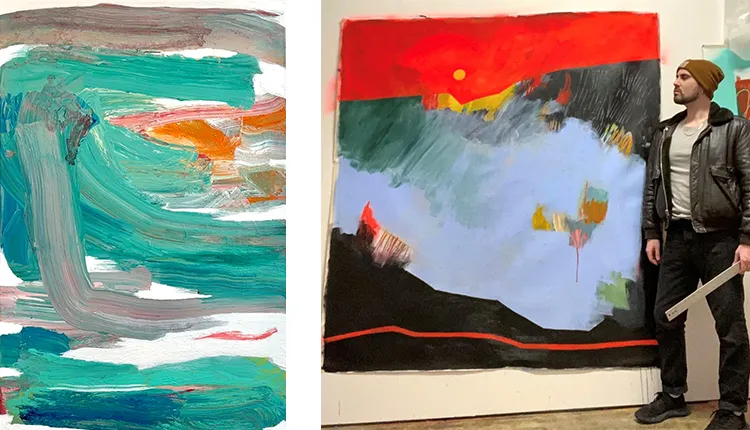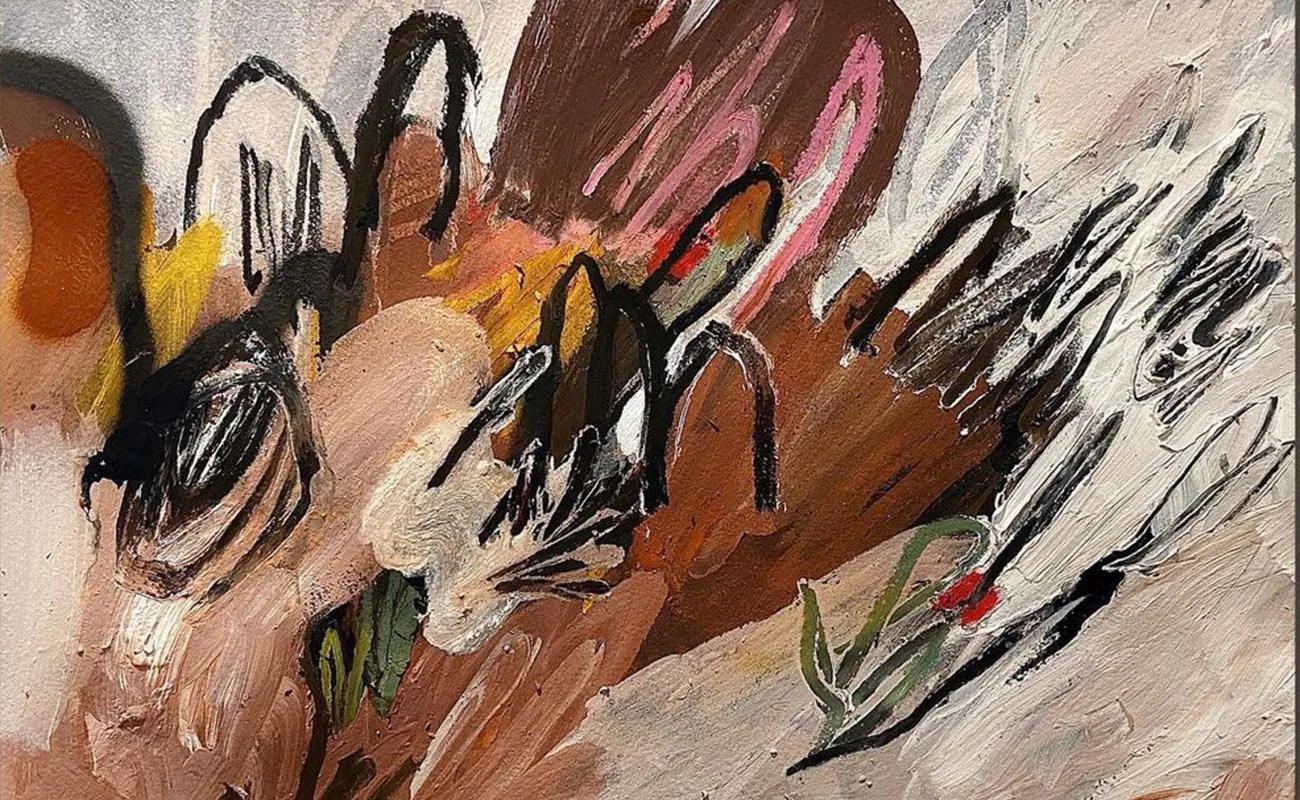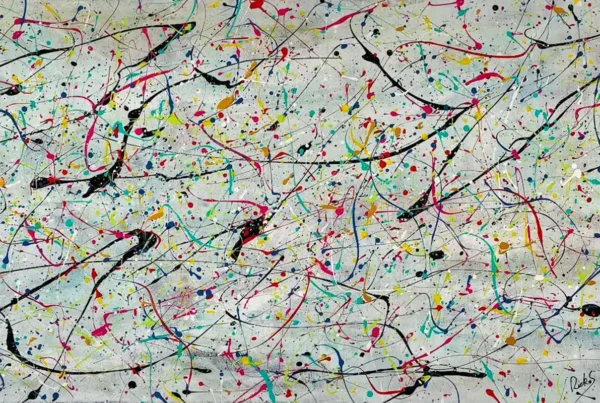A Physical Approach to Art
J.J. Ellis‘ transformation from butcher to contemporary artist is nothing short of extraordinary. The connection between these two seemingly unrelated professions lies in their shared engagement with materiality. Ellis explains that his previous occupation instilled in him a deep awareness of texture, structure, and process—elements he now carries into his artistic practice. In both butchery and painting, hands-on work and immersion in raw materials are central to the experience. For Ellis, this hands-on approach helped him build a creative language where physicality and spontaneity take precedence over intellectual abstraction. His paintings embody this connection to rawness, offering a sense of controlled chaos that mirrors his former trade.
The painter draws fascinating parallels between the primal act of butchery and his current work with color and form. In both disciplines, there is an element of messiness that must be harnessed and shaped into something meaningful. Ellis describes how breaking down meat required an intimate understanding of the inherent rhythms and structures within. This same understanding of material complexity informs the way he layers colors, creating works that are not only visually compelling but also viscerally charged. For Ellis, it’s all about finding honesty within the process, whether he’s handling flesh or paint.
When Ellis speaks of his artistic process, it becomes clear that his paintings are more than just a result of skill—they are a continuation of his life’s physicality. He emphasizes the importance of working directly with his materials, whether through gestural brushstrokes or bold, abstract forms. His pieces often have a tactile quality, as if the paint is alive, constantly in motion. This interaction with the canvas, rooted in spontaneity, enables him to create works that feel immediate and raw.

J.J. Ellis: The Dance Between Control and Chaos
Ellis’ approach to creating art can best be described as a delicate dance between control and chaos. He rarely plans his compositions in advance, opting instead to let the materials guide him through the process. For Ellis, spontaneity is the heart of his creativity. His method involves allowing colors, shapes, and lines to blur into one another, building layers that interact in unexpected ways. This lack of premeditation keeps his work fluid, constantly shifting between moments of clarity and confusion. In his words, the goal is to “capture fleeting thoughts or emotions,” reflecting the unpredictability of both the human mind and the world around us.
The artist’s work often merges abstract forms with subtle hints of figuration, blending the boundaries between representation and abstraction. His gestural lines introduce a dynamic energy to the canvas, creating a tension between hard-edged shapes and fluid, organic marks. It is this interplay that gives his work its unique visual language—a conversation between order and disorder. Each piece evolves as he paints, taking on a life of its own. Ellis views the completed work as a record of this journey, a document of the creative tension between control and letting go.
Ellis’ connection to movements like Abstract Expressionism and influences such as Jean-Michel Basquiat and Willem de Kooning is evident in the gestural energy of his work. Yet, he resists being confined to any single artistic tradition. His paintings pull from various influences, ranging from the immediacy of urban grit to the subconscious mark-making associated with Surrealist automatism. For Ellis, the magic lies in blending these approaches into something uniquely his own—something that speaks not only to his personal journey but also to the chaotic, ever-changing world we inhabit today.

Embracing Uncertainty in Art and Life
Navigating the unpredictability of today’s world has profoundly shaped Ellis’ philosophy on art-making. In a time of constant upheaval, he finds solace in the creative process itself, viewing it as a way to communicate with both the outside world and his inner self. Ellis believes that the chaos we experience in everyday life should not be avoided, but rather embraced as an integral part of artistic creation. His work reflects this mindset, balancing between moments of clarity and confusion. It is an honest portrayal of what it means to create in a time when nothing feels certain.
For Ellis, art serves as a way to cut through the noise of a complicated world, creating spaces of beauty in times of difficulty. He asserts that art should not always be about pushing boundaries or creating something entirely new. Instead, there is power in returning to the core of what art is meant to do—communicate beauty and meaning. In his view, creating something beautiful is a radical act, especially in an era when so much is uncertain. This philosophy drives his work, urging him to strip away unnecessary complexities and focus on what truly matters: creating something that speaks to human experience.
This desire for simplicity and authenticity permeates every aspect of Ellis’ creative process. He seeks to make art that is effortless in its execution, resisting the temptation to overthink or overcomplicate. The result is work that feels spontaneous and immediate, speaking to viewers on an instinctual level. Ellis compares his process to the natural world, suggesting that creating art should be as effortless as a bird singing. It’s a reflection of humanity’s need for beauty and connection, even when everything around us feels chaotic.

J.J. Ellis: The Power of Honest Creation
Staying true to one’s vision in the art world can be challenging, but for Ellis, it is non-negotiable. His journey from butcher to artist has taught him the importance of authenticity—both in his work and in the way he approaches life. One of the key lessons Ellis emphasizes is the value of decisiveness. Whether carving meat or making a mark on a canvas, the act of committing to a decision is central to creating something meaningful. In a world full of distractions, Ellis advocates for artists to remain focused on their vision, trusting that everything else will fall into place once they achieve that sense of clarity.
Ellis’ commitment to this philosophy has helped him navigate the art world with confidence. His advice to emerging artists is clear: know what you’re about and stand by it. For Ellis, success in the art world is not just about talent or connections—it’s about respecting yourself, your time, and your work. This means pricing art fairly, not compromising on one’s vision, and maintaining honesty in every interaction with the canvas. Ellis believes that the connection between artist and artwork is sacred, and nothing else should take precedence over that relationship.
Looking ahead, Ellis is focused on continuing to create work that reflects his intentional approach to both art and life. His newly completed studio offers him the space to explore new projects, while he remains committed to selling and sharing his current body of work. In the future, Ellis hints at the possibility of offering prints of some of his most loved pieces, giving them new life in a different medium. However, for now, he is dedicated to getting his original paintings out into the world, driven by the same raw, honest energy that has defined his career from the very beginning.






